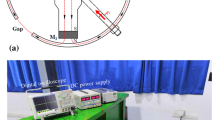Abstract
The apparent shear stress from plate–plate magnetorheometry, using the commercial magnetocell MRD180/1T (Physica/Anton Paar) in standard configuration, is distinctly overestimated. The effect is due to a flux density maximum near the sample rim and radial migration of iron particles towards the rim. Radial magnetic flux density profiles were investigated by finite element simulations using the Maxwell®2D code and by direct Hall probe measurements. The reliability of the finite element method results, both for the empty magnetocell and with magnetorheological fluid (MRF) in the measuring gap, allows conclusions on the true flux density within the MRF, which cannot be accessed by Hall probe measurements. If the MRF sits on top of the bottom yoke (standard configuration), the flux density maximum reaches twice the plateau value (0.74 T for 3 A coil current and 0.3 mm gap height of the investigated MRF). This yields a higher effective flux density and causes radial iron particle migration, resulting in an additional magnetic flux increase near the rim due to augmented MRF magnetisation. As a result, the rotor torque at constant rotary speed increases with time. Reliable results are achieved by a modification of the magnetocell, such that the MRF sits on a non-magnetic Hall disc of 1.5 mm thickness, allowing an online flux density measurement by a FW Bell Hall probe. In this configuration, the radial flux density profile near the rim remains sufficiently flat and no iron particle migration is detected.















Similar content being viewed by others
References
Gabriel C, Laun HM (2007) Development of a double-gap shear cell for the characterization of magnetorheological fluids. Deutsche Rheologentagung, Berlin, Germany, 22–23 March 2007
Gabriel C, Laun HM, Oetter G, Kieburg C (2007) Application related challenges in the characterization of magnetorheological fluids. Annual European Rheology Conference, Napoli, Italy, 12–14 April 2007
Goncalves FD, Koo JH, Ahmadian M (2006) A review of the state of the art in magnetorheological fluid technologies—part I: MR fluid and MR fluid models. Shock Vibr Dig 38(3):203–219
Jolly MR, Bender JW, Carlson JD (1996) Properties and application of commercial magnetorheological fluids. SPIE 5th Int Symposium on Smart Structures and Materials, San Diego, CA
Kieburg C, Oetter G, Lochtman R, Gabriel C, Laun HM, Pfister J, Schober G, Steinwender H (2007) High performance magnetorheological fluids tailored for a 700 Nm automotive 4-wheel-drive clutch. In: Gordaninejad F, Graeve OA, Fuchs A, York D (eds) Proceedings of the 10th international conference on ERMR 2006, “electrorheological fluids and magnetorheological suspensions”. World Scientific, Singapore, pp 101–107. ISBN-13 978-981-277-119-3
Klingenberg DJ (2001) Magnetorheology: applications and challenges. AIChE J 47:246–249
Laeuger J, Wollny K, Stettin H, Huck S (2004) A new device for the full rheological characterization of magneto-rheological fluids. Int J Mod Phys B 19:1353–1359
Laun HM, Gabriel C (2007) Measurement modes of the response time of a magneto-rheological fluid (MRF) for changing magnetic flux density. Rheol Acta 46:665–676
Laun HM, Gabriel C, Schmidt G (2007) Primary and secondary normal stress differences of a magnetorheological fluid (MRF) up to magnetic flux densities of 1 T. J Non-Newton Fluid Mech 148:47–56
Popovic DR, Dimitrijevic S, Blagojevic M, Kejik P, Schurig E, Popovic RS (2007) Three-axis teslameter with integrated Hall probe. IEEE Trans Instrum Meas 56:1396–1402
Rabinow J (1948) The magnetic fluid clutch. AIEE Trans 67:1308–1315
Wollny K, Laeuger J, Huck S (2002) Magneto sweep—a new method for characterizing the viscoelastic properties of magneto-rheological fluids. Appl Rheol 12(1):25–31
Acknowledgements
The Senis Hall probe results in Fig. 5 were kindly provided by Dr. Läuger of Physica/Anton Paar. We would like to acknowledge the valuable support of Dr. Huck of Anton Paar, in particular for providing details of the magnetocell for flux density simulations. Mathias Bach is thanked for performing most of the magnetorheometry experiments.
Author information
Authors and Affiliations
Corresponding author
Rights and permissions
About this article
Cite this article
Laun, H.M., Schmidt, G., Gabriel, C. et al. Reliable plate–plate MRF magnetorheometry based on validated radial magnetic flux density profile simulations. Rheol Acta 47, 1049–1059 (2008). https://doi.org/10.1007/s00397-008-0305-0
Received:
Accepted:
Published:
Issue Date:
DOI: https://doi.org/10.1007/s00397-008-0305-0




